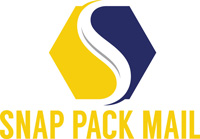
Questions and Answers About Pressure Seal Paper
Q: What is Pressure Seal?
Pressure Seal is a system comprised of a one-page self sealing document and/or a folder/sealer for sealing the document.
Q: How is a pressure seal form sealed?
The form is sealed though a process of folding the form on a pressure seal fold-er/sealer. Folding the form aligns patterns of “cohesive” which have been pre-applied to the document during manufacture. Once folded, the document travels through a series of sealing rollers inside the folder/sealer. These rollers apply pressure to the form, which activates the cohesive and in turn creates a secure “fiber tear” seal.
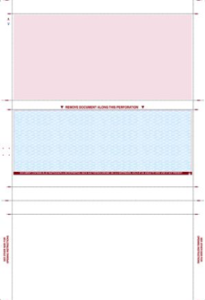 Q: Why is pressure seal glue called “cohesive” and not adhesive?
Q: Why is pressure seal glue called “cohesive” and not adhesive?
Unlike a standard adhesive, a cohesive requires two patterns placed on top of each other to create the bond. In the case of a pressure seal cohesive, very high pressure is required to activate the bond.
Q: If pressure activates the cohesive why doesn’t pressure from a laser printer cause the activation?
Pressure Seal cohesive only reacts when it comes in contact with itself under very high pressure. Pressure and heat as found in a printer has no affect on the pattern.
Q: Does “cohesive” have little capsules that break when under pressure?
Some say that the cohesive is microencapsulated, however this is not true. Pressure Seal cohesive has no capsules to break. The chemistry is not like that of carbonless paper. The correct term for the bond is Mechanical Bonding. Press two cohesive surfaces together hard enough and they will form a bond.
Q: Are there different types of cohesives in the market today?
There are numerous types of cohesive in the market today. The types, chemistry additives and method of application vary from manufacturer to manufacturer. However, the method and process used to apply the cohesive to the form may be more important than the type of cohesive used.
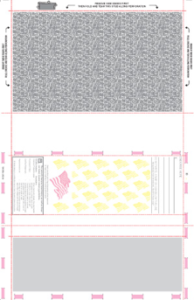 Q: Can heat or extreme cold affect a pressure seal form?
Q: Can heat or extreme cold affect a pressure seal form?
Once manufactured, cold or heat should not affect the product as long as the product is properly wrapped. However, the product should be acclimated to a print room for at least 48 hours before imaging. The raw cohesive material is another story. If the temperature of the raw cohesive drops below freezing, the material is destroyed and cannot be used. This is a quality control issue for the forms manufacturer.
Q: Are there any special handling issues before or after imaging?
Absolutely. Product must be kept in its original wrap to ensure proper moisture content of the paper is maintained. Product should be climatized in the imaging environment at least 48 hours prior to imaging. Once imaged, the product should be placed curl side down to remove any curl caused by passing through the print device. In general, forms should be put through the folder/sealer on the same day that they are imaged.
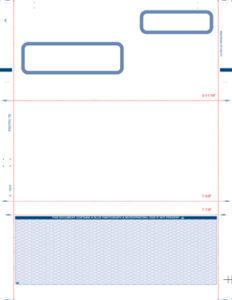 Q: What makes a good Pressure Seal form?
Q: What makes a good Pressure Seal form?
Proper cohesive chemistry and a proper method of applying the cohesive to the form are key. Pressure seal cohesive is a volatile compound which requires active Quality measurement during the entire manufacturing process. Important as well is accurate perforation registration to ensure proper alignment of the perforations and cohesive pattern during folding. Fold assist perforations that float in and out of registration will cause folding problems on a typical folder/sealer. In addition, this may cause the cohesive pattern to align improperly when the form is folded. Floating registration of perforations will cause feeding problems on a folder/seal-er and result in a poorly sealing form. Other factors that play an important part in a good quality pressure seal form are paper type, print quality, packaging and storage. It is important to select a forms manufacturer with knowledge of the critical factors involved in manufacturing pressure seal forms and consistency is key.
Q: What should one expect from the form and the folder/sealer?
The form should show an aggressive fiber tearing bond after folding and sealing. Anything less is not acceptable. The horizontal perforations on the form should remain in tight registration and not float from form to form. Other specifications of the form such as print quality and cut off accuracy should adhere to normally accept-ed printing industry standards. The folder/sealer selected for the application should be a good fit as far as speed and capacity. The machine selected should show ease of use and robust construction to stand up to the high sealing pressure required to achieve a proper secure seal.
Q: Why are there so many different pressure seal patterns?
Some cohesive patterns are patented. Some patterns are used for postal and print-er considerations, while others have to be used to allow for the forms manufacturing process. Other patterns are used to allow for different ways of opening the sealed document. In general, one may stick with a few of the basic fold and cohesive patterns for a large share of the pressure seal applications. However, there are unique patterns which may offer distinct benefits to the end user. Consulting with a trained pressure seal print professional is worthwhile.
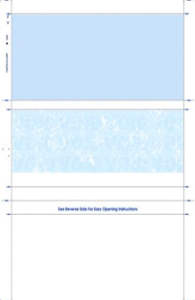 Q: Why doesn’t my form seal tightly?
Q: Why doesn’t my form seal tightly?
There are many variables some of which have already been discussed. Is the impression on the folder/sealer sufficient? Is the machine poorly designed or not robust enough for the process? Were the forms manufactured with a poor quality cohesive or did the manufacture use poor quality processes when applying the cohesive to the form? Are the positions of the fold perforations “floating” from form to form or from ream to ream? Do the cohesive patterns align properly after the form is folded. This is especially important and very easy to check. Were the wrong raw materials used. Were the forms stored properly and allowed to acclimate prior to use? A consultation with a pressure seal trained print professional will help avoid many or all of these problems.
Q: Why do my forms keep jamming in the printer?
Again, there are many variables. Maintenance issues on the printer, forms having excessive curl or flexed edges, forms may be blocking or sticking together, weak or poor perforations. However, try to rule out any issues with the printer itself before looking at the pressure seal form as the culprit.
Q: Why does toner transfer onto the sealing rollers of my folder/sealer?
Toner transfer or build-up will occur due to the fact that some toner is placed on the outside of the folded document. However, excessive toner build-up can occur as a result of poor toner fusion to the sheet. This is a printer issue. Some toner transfer will occur. Knowing this and dealing with it on a regular basis will avoid problems.
Q: Can any paper be used on Pressure Seal applications?
No. Only specific papers are compatible with Pressure seal technology.
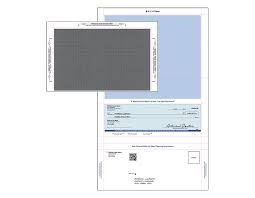 Q: What about weight of the paper?
Q: What about weight of the paper?
Usually 24# and 28# papers are used although 38#, 80# & 100# tag can be used for some applications along with certain security papers. However, one should be aware that not all folder/ sealers handle these heavier basis weights.
Q: What is the shelf life of the finished form?
Normal shelf life is from 6 months to a year. Assuming proper packaging and storage. Forms that are left exposed to the air will see a rapid deterioration in sealing performance. Leftover reams and partial reams of forms should not be left out. They should be placed back inside their cartons interior bag until the next use.
Q: What’s the issue with high-end printers and a pressure seal form?
High-end printers sometimes use oils or agents to assist in the transport of the document through the imaging process. Oils or agents can inhibit the seal. A forms manufacturer with knowledge and background in dealing with high-end printer issues will help ensure success.
Q: Why does print ink offset on to my folder/sealer’s sealing rollers?
Forms use inks which take time to dry. The moisture consistency of the form must be maintained. Thus, the reason for wrapping the forms in a moisture proof wrap. This wrap may not allow the ink to dry fully. The extent of the drying of these inks depends on the density of the color and the coverage area. This drying process can take up to 6 to 8 weeks. Forms printed using U.V. cured inks have no offset-ting issues. In general, forms that contain large solid areas of ink or have heavy ink coverage should be printed using U.V. printing inks on a U.V. equipped printing press. Does your supplier do this now?
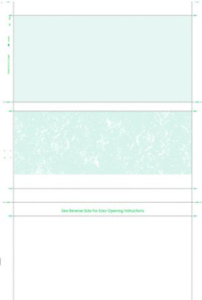 Q: Why do my forms keep jamming in the folder/sealer?
Q: Why do my forms keep jamming in the folder/sealer?
Forms issues can be the following: curl in the paper, floating registration of fold perforations, dull or dead spots in the fold assist perforations, excessive paper dust creating a build-up on feed and fold rollers, the paper and folder/sealer may be incompatible, forms may be placed in the feeder wrong folder/sealer issues may be the following: Wrong feed adjustments, wrong fold plate adjustments, bent fold plates, or debris in the paper path, worn or burnt out parts, buildup of ink or toner on the transfer and sealing rollers. Is the folder/sealer being properly maintained and under service with a properly trained service network? Many of the above problems can be diagnosed via telephone technical support to get you back up in a very short time.
Q: How do I choose a folder/sealer that is right for my application?
The duty cycle per month is important. However, consideration must be taken as to the quantity per each individual print run. Are there seasonal fluctuations in print volume that may require a larger machine during those periods? Sometimes two smaller units vs. one large one can be the better approach. It is sometimes better, especially on mission critical applications, to have two machines providing redundancy in the event of down time. Other considerations are: the length and width of the form, the fold depths, paper basis weight, and ease of use. A good way of comparing one system over another is to look at the weight of the equipment. Lightweight, lightly constructed folder/sealers are just not going to last over the long haul. Choose a well built machine with a heavy duty sealing section that will last. Total weight of the folder/sealer is a good indication of a well built machine.
Q: Why do some companies claim that their forms are patented?
Both forms construction, cohesive patterns have been and continue to be patented. These products can be purchased through the manufacturers that have obtained the patent or from companies who have licensed through the originator. However, pricing may be at a premium due to licensing fees, etc.
Purchasing product from a manufacturer who either knowingly or unknowingly sells patented product can be trouble for both the manufacturer and the sales rep. “Similar to” products can be developed and purchased without the worry of patent infringement. These product changes have no direct affect to the end use of the form.
Have any other Pressure Seal Paper FAQS?
Click the button below and let us know any questions that we can answer and we will post here.
